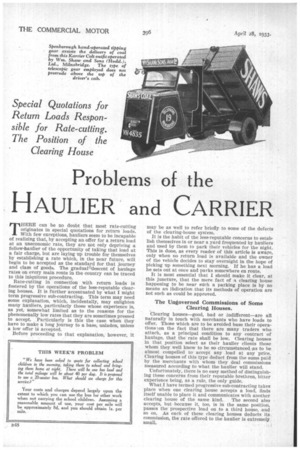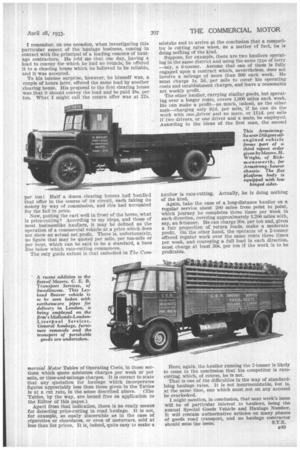Problems of the
Page 66

Page 67

If you've noticed an error in this article please click here to report it so we can fix it.
HAULIER and CARRIER THERE can be no doubt that most rate-cutting originates in special quotations for return loads. With few exceptions, hauliers seem to be incapable of realizing that, by accepting an offer for a return load at an uneconomic rate, they are not only depriving a fellow-haulier of the opportunity of taking that load at a fair charge, but are laying up trouble for themselves by establishing a rate which, in the near future, will begin to be accepted as the standard for that journey and class of goods. The gradualNescent of haulage rates on every main route in the country can be traced to this iniquitous procedure.
Rate-cutting in connection with return loads is fostered by the operations of the less-reputable clearing houses. It is further accentuated by what I might term progressive sub-contracting. This term may need some explanation, which, incidentally, may enlighten many hauliers, particularly those whose experience is, as yet, somewhat limited as to the reasons for the phenomenally low rates that they are sometimes pressed to accept. Particularly is this the case when they have to make a long journey to a base, unladen, unless a low offer is accepted.
Before proceeding to that explanation, however, it may be as well to refer briefly to some of the defects of the clearing-house system.
It is the habit of the less-reputable concerns to establish themselves in or near a yard frequented by hauliers and used by them to park their vehicles for the night. This is done, as every reader of this article is aware, only when no return load is available and the owner of the vehicle decides to stay overnight in the hope of picking up something next morning. If he has a load he sets out at once and parks somewhere en route.
It is most essential that I should make it clear, at this juncture, that the mere fact of a clearing house happening to be near stich a parking place is by no means an ihdication that its methods of operation are not such as could be approved.
The Ungoverned Commissions of Some Clearing Houses.
'Clearing houses—good, bad or indifferent—are all naturally in touch with merchants who have loads to offer. Those which are to be avoided base their operations 'eon the fact that there are many traders who attach, as a principal condition to any contract of haulage, that the rate shall be low. Clearing houses in that position select as their haulier clients those whom they well know to be so circumstanced,-gs to be almost compelled to accept any load at any price. Clearing houses of this type deduct from the sums paid by the merchants with whom they deal commissions measured according to what the haulier will stand.
Unfortunately, there is no easy method of distinguishing these concerns from their reputable brethren, bitter experience being, as a rule, the only guide.
What I have termed progressive sub-contracting takes place when one clearing house accepts a load, finds itself unable to place it and communicates with another clearing house of the same kind. The second also accepts, but because it, too, is in the same position, passes the prospective load on to a third house, and so on. As each of these clearing houses deducts its commission, the rate offered to the haulier is extremely small.
I remember, on one occasion, when investigating this particular aspect of the haulage business, coming in contact with the principal of a leading concern of haulage contractors. He told me that one day, having a load to convey for which he had no vehicle, he offered it to a clearing house which he believed to be reliable, and it was accepted.
To his intense surprise, however, he himself was, a couple of hours later, offered the same load by another clearing house. His proposal to the first clearing house was that it should convey the load and be paid 48s. per ton. What I might call the return offer was at 27s.
per ton! Half a dozen clearing houses had handled that offer in the course of its circuit, each taking its moiety by way of commission, and this had accounted for the fall in price.
Now, putting the cart well in front of the horse, what is price-cutting'? According to my ideas, and those of most businesslike hauliers, it may be defined as the operation of a commercial vehicle at a price which does not show an actual net profit. There is, unfortunately, no figure that may be quoted per mile, per ton-mile or per hour, which can he said to be a standard, a base line below which rate-cutting commences.
The only guide extant is that embodied in The Coin mercial Motor Tables of Operating Costs, in those sections which quote minimum charges per week or per mile, or time-and-mileage charges. It is correct to state that any quotation for haulage which incorporates figures appreciably less than those given hi the Tables is at a cut rate, in the sense described above, (The Tables, by the way, are issued free on application to the Editor of this paper.).
Apart from that indication, there is no ready means for detecting price-cutting in road haulage. It is not, for example, so easily discernible as in the case of cigarettes or chocolates, or even of motorcars, sold at less than list prices. It is, indeed, quite easy to make a
mistake and to arrive at the conclusion that a competitor is cutting rates when, as a matter of fact, he is doing nailing of the kind.
Suppose, for example, there are two hauliers operating in the same district and using the same type of lorry —say, a 6-tonner. Assume that one of them is fully engaged upon a contract which, nevertheless, does not involve a mileage of more than 300 each week. He must charge is. 511. per mile to cover his operating costs and establishment charges, and leave a reasonable net weekly profit.
The other haulier, carrying similar goods, but operating over a longer route, covers 1,000 miles each week. He can make a profit—as much, indeed, as the other man—charging only 9id. per mile, if he can do the work with one .driver and no mate, or 111d. per mile if two drivers, or one driver and a mate, be employed. Aosording to the ideas of the first man, the second haulier is rate-cutting. Actually, he is doing nothing of the kind.
Again, take the case of a long-distance haulier on a regular service about 200 miles from point to point, which journey he completes three times per week in each direction, covering approximately 1,200 miles with, say, an 8-tonner. He can charge 30s. per ton and, given a fair proportion of return loads, make a moderate profit. On the other hand, the operator of a 2-tonner offered regular work over the same route three times per week, and conveying a full load in each direction, must charge at least 50s. per ton if the work is to be profitable.
Here, again, the haulier running the 2-tonner is likely to come to the conclusion that his competitor is ratecutting, which, of course, he is not.
That is one of the difficulties in the way of standardizing haulage rates. It is not insurmountable, but is, at the same time, one which must not on any account be overlooked.
I might mention, in conclusion, that next week's issue will be of particular interest to hauliers, being the annual Special Goods Vehicle and Haulage Number. It will contain authoritative articles on many phases of goods road transport, and no haulage contractor
should miss the issue. S.T.R.




































































































